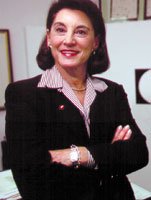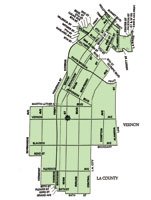One on One With Jan Perry and Ilse Metchek
Los Angeles’ fashion district has a new city-council member. Jan Perry now represents the 9th district, taking over for Rita Walters.
Perry’s 9th district covers the majority of the fashion district, although council member Nick Pacheco’s 14th district includes the California Mart, the New Mart and the Cooper Building.
The bilingual Perry comes to the position with 10 years experience as a Los Angeles city employee. She worked as senior planning deputy, legislative deputy and chief of staff for the 9th district under Walters and worked as chief of staff for 10th district councilman Nate Holden. She also served as executive director of the City of Los Angeles Census 2000 outreach project, working with more than 400 community organizations. Perry is a close neighbor of the district, living just east of it.
California Apparel News asked Ilse Metchek, executive director of the California Fashion Association and L.A. By Design, to meet with Perry to ask her to address some of the key concerns of the industry. Perry quickly turned the interview around—querying Metchek about the apparel industry and its relationship with the city.
Ilse Metchek: Under Mayor [Tom] Bradley, we had a mayor’s office liaison. They really thought we were something to celebrate. But since that time, the perception of local manufacturers as nothing more than sweatshops has been on everybody’s mind. How can we help you help us to garner the kind of accolades that Mayor Giuliani gets for New York, when we’re a bigger and more important industry?
Jan Perry: Tell me what Mayor Bradley did.
IM: Mayor Bradley had a liaison for the apparel industry, Barbara Trister, and before that, Bea Lavery. Bea took an existing association, the CFC [California Fashion Creators], and made it a house association. When we had fashion shows for market week, there was a melding of the entertainment and apparel industries. Everything that was flash and dash, Mayor Bradley was for. Then came the El Monte crisis, and at that time there was no association to speak on behalf of the industry. So in 1994, Mayor [Richard] Riordan convened the apparel industry round table and the California Fashion Association was born. That’s when I started.
JP: So the round table came out of El Monte?
IM: Yes. There were two reasons we were born. When I was managing the California Mart and I went all over the world, I found out that Los Angeles was a fly-by. No one really knew that there was an apparel industry here. So we formed the association for international awareness of the industry and to have a point of information for issues like the El Monte crisis. Its purpose is to disseminate information and education and outreach. But as you know, there are roadblocks, and some of them are legislative.
JP: One thing I can tell you, having done the census for the whole city and focusing on outreach and disseminating information about the census and why it was relevant to various types of communities—anywhere from the disabled community to the monolingual community to the African-American community or the indigenous community or the homeless community—we devised strategies for reaching those people and telling them why the census [would] benefit their community. We got the count up 10 percent—and I would probably implement those same strategies working with the apparel industry.
IM: We’d love that. But there are certain legislative issues in our way. There isa disconnect between a city license and the state registration. A new company has no way of knowing about the registration requirements until they are caught in this “I did not know” process. The other is a social issue. If an undocumented worker takes a job in an apparel factory, that shop is violating state law and is added to the sweatshop statistics. We are the only industry that has to jump through these hoops.JP: What is the statutory history on that?IM: Registration was put in in 1987. California and New York are the only states that [require] registration.
JP: Was it always that way?
IM: No, AB633 put more teeth into it. [Assembly Bill 633 makes an apparel manufacturer liable for labor law violations by its contractors.] The registration requirement is the single biggest obstacle for an illegal immigrant who can sew, who has been in this country for years and years and years, to work at a legitimate plant. Mexico’s President Fox has announced that he supports a program that allows Mexican citizens to continue working in the U.S. if they can show that they already have a job in the U.S.
JP: Did any advocacy group file a brief on this?
IM: The industry has a separate legislative advocacy organization raising a bit of money to fund an amicus brief against the passing of AB633, which both the legislators and regulators ignored. What we would love to have you look into is what can we do to support realistic business-friendly solutions and practices.
JP: I know [they’re] very different. It’s [the apparel industry] a micro-economy; it’s subtle.
IM: It’s subtle if you are referring to the underground side of the industry. The issue is this: When all of these local apparel factories closed because of the passage of the North American Free Trade Agreement, nobody went to the unemployment office. This industry teaches people hand-eye coordination. When they leave an apparel factory, they go into food processing; they go into aerospace; they go into entertainment. No one leaves this business untaught. The problem is, we have a lot of companies who now want good, solid apparel-industry workers, but they’re gone. They’re at Motorola or they’re putting computer chips together. We don’t put people on the unemployment line. [Still,] most people think of the entire 120,000 people [in Los Angeles’ apparel industry] as working in sweatshops.
JP: You can drive around the area and you can see where the sweatshops are and are not.
IM: The Federal Department of Labor and California Department of Industrial Relations are giving up because in eight years they haven’t been able to make an inroad in enforcing labor laws. They are frustrated because they can’t get to those businesses that are violating the laws. In the world of business, if you are working on a program for eight years and there’s no change for the better, fix the program, don’t blame the industry. There needs to be some tracking software.
JP: There’s a couple of things [that are needed]: tracking software that generates notification in the primary language, and then something to notify the city or the city council the same way the Building and Safety [Department] notifies us whenever a permit is pulled.
IM: But it can’t just be Los Angeles; it’s got to be every city in California. The only way the Department of Labor finds the perpetrators of fraud is by taking random registered contractors and visiting them. Now, if you’re not registered, they can’t find you.
I have a great story. One of the previous labor commissioners, a week before he left office, took what is called the TIP program, where the state and federal government go together to investigate factories. They went to five apparel companies in Orange County and they brought with them a reporter from the Los Angeles Times. There was nothing wrong with any of the places, but they never printed that.
JP: Why?
IM: The story was that the reporter was going with them on a raid. And each factory was okay; they had their registration; they had the time clock up. Being legitimate was not a good story.
We’re losing a lot of business to Florida, to Pennsylvania, to Arizona. It [comes back to] this whole negative perceptionhellip;.
We’re really on a tear for a visual impact, to meld apparel and entertainment, to hold big fashion shows. [There is some discussion now] about closing off the street between the Cooper Building and the Cal Mart for a show in April 2002. We would love to have you wave our flag.
JP: I’m heavy on outreach. I tend to tailor strategies based on the individual. That’s how I ran my campaign. My dad was in the military and [that’s how I ran] my campaign—-I kept deploying specific information at strategic times. I was always an outside/inside person...and [I’ve] always been a community-focused person. Community can mean a lot of things. There are things about a community that [you don’t know] if you don’t get an opportunity to go talk to people about their issues. I think I bring another sensitivity [to this position]. The projects should be incubators and generators to allow [people] to empower themselves and to pull themselves up.
IM: And to showcase themselves. Look what happened down here since the Clean & Safe Team started under the Business Improvement District. That whole Santee Alley marketplace happened because the perception was that you’re not going to get mugged or robbed. Clearly we think the general business community will be helped by just changing the perception that it’s “that little industry down there.”
When you think of the sewing portion of this industry, let us realize there are 2,500 registered contractors in Los Angeles. The average size is 25 people per factory.A skilled worker’s pay scale is not in jeopardy. A factory must have skilled workers to be efficient. Skilled workers are in demand. These are not the workers that are paid outside the law.
JP: I’m looking forward to this.
























